Box tree moth
Cydalima perspectalis
Appearance
The moth of the box tree moth reaches a wingspan of 25-30 mm and shows a very characteristic wing pattern. The forewings are white in colour and have a broad black-brown band on the front edge and seam. A small brown bulge and a crescent-shaped white spot can be seen in the centre of the front pair of wings. The white hind wings are also brown-edged. Completely brown-coloured moths with a white spot also occur.
The caterpillars grow up to 5 cm long, are yellow-green in colour and have black and white longitudinal stripes, black dots, white bristles and a black head capsule.
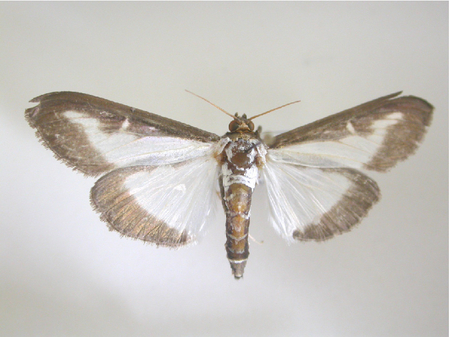
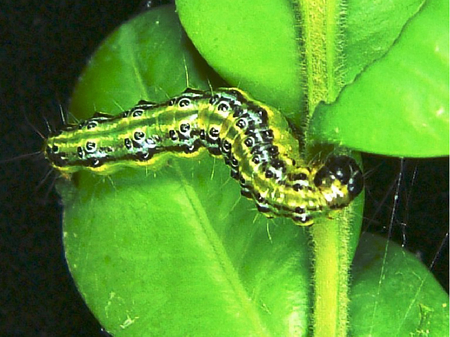
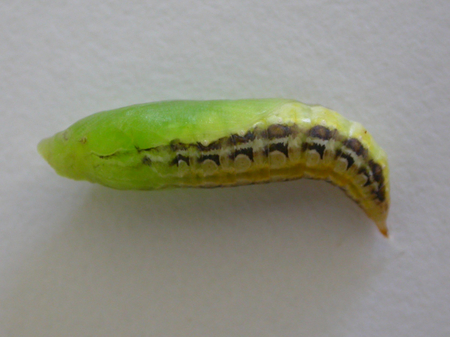
Biology
The box tree moth Cydalima perspectalis (synonym: Diaphania perspectalis) belongs to the family ofcrambid moths(Crambidae).
The moths fly from June and lay their shield-shaped yellowish eggs in small groups on the underside of the leaves. The caterpillars that hatch from these eggs live in loose webs and go through six larval stages, whereby the caterpillars reach a size of up to 5 cm. Pupation takes place in a cocoon on the host plant. After a short pupal period, a finished moth emerges from the cocoon. The box tree moth goes through its development cycle three times each year - we speak of three generations.
The box tree moth overwinters as a caterpillar in a web on the host plant. After overwintering, the caterpillars start feeding from mid-March to early April.
Damage symptoms
The loose webs in which the caterpillars live and feed on the leaves are conspicuous. At the beginning, they only scrape the inner and lower leaves of the box tree, which is why they are often overlooked at the beginning of the season.
Over the course of the year, they are able to completely defoliate their host plant and subsequently cause it to die. If there is a lack of food, they also feed on the green parts of the bark.
The caterpillars' droppings, which collect in the webs and on the leaves, are also conspicuous.
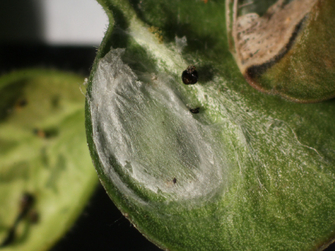
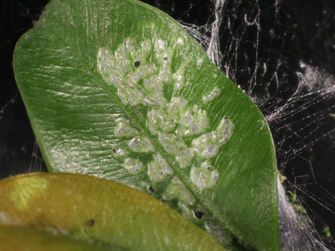
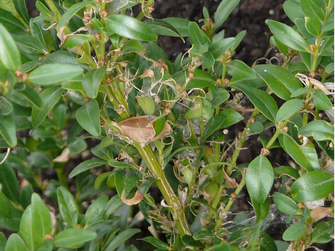
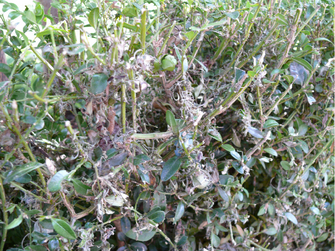
Distribution
The boxwood borer originates from Japan and was first discovered in Europe in 2007 in Germany. From there, it has spread steadily. In Austria, the first occurrence of the boxwood borer was reported in Vorarlberg in 2009. Later, it was also found in Styria and Lower Austria. The pest is now widespread throughout Austria.
Vorbeugung und Bekämpfung
- Kein Kauf/Aussetzen bereits befallener Jungpflanzen
- Befallene Pflanzen nicht in befallsfreie Gebiete verbringen
- Besondere Vorsicht in der Umgebung von Friedhöfen, dort werden erfahrungsgemäß häufig befallene Pflanzen ausgesetzt
- Regelmäßige Befallskontrollen der inneren und unteren Bereiche der Buchsbäume von März bis Oktober
- Überprüfung des Falterfluges mittels Pheromonfallen
- Mechanisches Ausschneiden der Gespinste und Absammeln der Larven mit anschließender Vernichtung (z.B. durch Einfrieren)
- Rückschnitt befallener Buchsbäume vorzugsweise nach der Eiablage des Falters
- Setzen von Ersatzpflanzen wie Berberitzen (Berberis spp.), Stechpalmen (Ilex spp.) oder Geißblatt (Lonicera spp.)
- Spritzbehandlung mit einem zugelassenen Mittel zur Bekämpfung des Buchsbaumzünslers bzw. von beißenden Insekten und freifressenden Schmetterlingsraupen im Zierpflanzenbau (siehe Verzeichnis der in Österreich zugelassenen Pflanzenschutzmittel)
- Das nützlingsschonende Bakterium Bacillus thuringiensis subsp. kurstaki kann als biologisches Pflanzenschutzmittel gegen Jungraupen eingesetzt werden
- Spritzbrühe unter hohem Druck (Gebläsespritze) ausbringen und alle Pflanzenteile gut benetzen
- Natürliche Feinde (z.B. Vögel) fördern. Es wurden bislang keine Parasiten an Buchsbaumzünslern festgestellt. Da sie die Giftstoffe des Buchsbaumes in ihrem Körper einlagern, sind sie auch für potentielle Fraßfeinde giftig bzw. unattraktiv. Jedoch wurden bereits einheimische Singvögel (wie Spatzen, Meisen, …) beim Füttern ihrer Jungen mit Buchsbaumzünslerraupen beobachtet.
Last updated: 07.08.2025
automatically translated